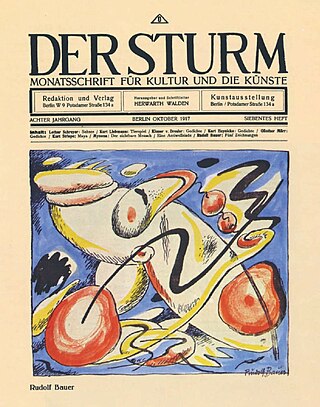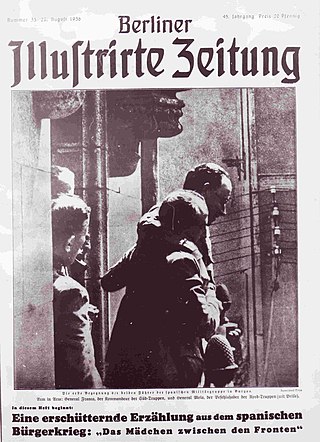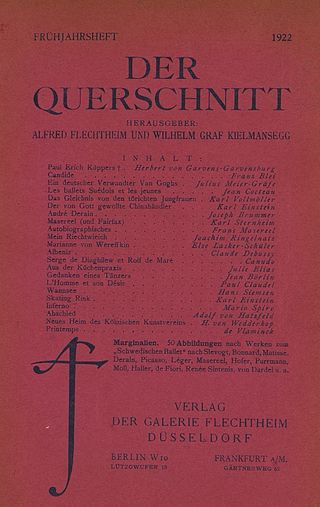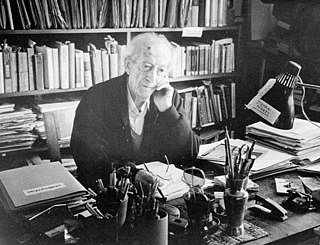Related Research Articles

Weimar culture was the emergence of the arts and sciences that happened in Germany during the Weimar Republic, the latter during that part of the interwar period between Germany's defeat in World War I in 1918 and Hitler's rise to power in 1933. 1920s Berlin was at the hectic center of the Weimar culture. Although not part of the Weimar Republic, some authors also include the German-speaking Austria, and particularly Vienna, as part of Weimar culture.

In art history, secession refers to a historic break between a group of avant-garde artists and conservative European standard-bearers of academic and official art in the late 19th and early 20th century. The name was first suggested by Georg Hirth (1841–1916), the editor and publisher of the influential German art magazine Jugend (Youth), which also went on to lend its name to the Jugendstil. His word choice emphasized the tumultuous rejection of legacy art while it was being reimagined.

Carl Einstein, born Karl Einstein, also known by pseudonym Savine Ree Urian, was an influential German Jewish writer, art historian, anarchist, and critic.

Der Sturm was a German avant-garde art and literary magazine founded by Herwarth Walden, covering Expressionism, Cubism, Dada and Surrealism, among other artistic movements. It was published between 1910 and 1932.

Arbeiter-Illustrierte-Zeitung or AIZ was a German illustrated magazine published between 1924 and March 1933 in Berlin, and afterward in Prague and finally Paris until 1938. Anti-Fascism and pro-Communism in stance, it was published by Willi Münzenberg and is best remembered for the propagandistic photomontages of John Heartfield.

Ludwig Renn was a German author. Born a Saxon nobleman, he later became a committed communist and lived in East Berlin.

Die Freundin was a popular Weimar-era German lesbian magazine published from 1924 to 1933. Founded in 1924, it was the world's first lesbian magazine, closely followed by Frauenliebe and Die BIF. The magazine was published from Berlin, the capital of Germany, by the Bund für Menschenrecht, run by gay activist and publisher Friedrich Radszuweit. The Bund was an organization for homosexuals which had a membership of 48,000 in the 1920s.

The Berliner Illustrirte Zeitung, often abbreviated BIZ, was a German weekly illustrated magazine published in Berlin from 1892 to 1945. It was the first mass-market German magazine and pioneered the format of the illustrated news magazine.

Der Querschnitt was an art magazine published by German art dealer Alfred Flechtheim between 1921 and 1936. The magazine was based in Berlin.
Garçonne was a Weimar-era German magazine for lesbians. It was published from 1926 to 1930 under the title Frauenliebe and from 1930 to 1932 as Garçonne.
Guter Rat is a monthly business and consumer magazine published first in the German Democratic Republic (GDR). The magazine is one of three East German magazines which have survived German reunification, including Eulenspiegel and das Magazin.
Die Freundschaft (Friendship) was a German Weimar-era gay magazine that was published from 1919 to 1933.

Oto Bihalji-Merin was a Serbian writer, art historian, painter and art critic.
Uhu was a monthly magazine published from 1924 to 1934 in Berlin by Ullstein Verlag. Today it is considered a pioneering publication of the Weimar period.

Otto Friedrich Wilhelm Stapel, was a German Protestant and nationalist essayist. He was the editor of the influential antisemitic monthly magazine Deutsches Volkstum from 1919 until its shutdown by the Nazis in 1938.
Das 3. Geschlecht, subtitled Die Transvestiten ("Transvestites"), was a transvestite magazine of Weimar Germany, published from 1930 until 1932 in Berlin. Published by the Radszuweit publishing house, it is believed to be the first transvestite magazine in history. A predecessor to the magazine was Die Freundin, a more lesbian-focused magazine that nonetheless published some columns appealing to transvestites.
Revue des Monats was a German language monthly general interest magazine which existed between 1926 and 1933 during the Weimar period in Berlin, Germany.

Julie Elias was a German fashion journalist and author of cookbooks, which also dealt with Jewish cuisine. She was worldly, highly educated, and during her lifetime known beyond the borders of Germany as a culinary salonnière and successful writer. In 1938, persecuted as a Jew, she had to flee Germany. After the destruction of European Jewry in the Holocaust, there were hardly any traces of her left in the public memory.
Koralle was a monthly popular science magazine which appeared in Weimar Republic and then in Nazi Germany between 1925 and 1944. It was one of the publications started by the leading German company Ullstein Verlag. Although it was started as a popular science magazine, it turned into a general interest magazine in 1933 when the Nazi Party began to rule the country.
Das Neue Russland was a magazine which was published in Berlin, Weimar Republic, between 1923 and 1933. It was official media outlet of the Society of Friends of the New Russia. Its subtitle was Zeitschrift für Kultur, Wirtschaft und Literatur.
References
- ↑ Patrick Rössler; Achim Bonte; Katja Leiskau (2012). "Digitization of Popular Print Media as a Source for Studies on Visual Communication: Illustrated Magazines of the Weimar Republic". Historical Social Research . 37 (4): 176. JSTOR 41756481.
- 1 2 "Illustrierte Magazine der Klassischen Moderne" (in German). Art Historicum. Retrieved 22 October 2021.
- 1 2 Anton Kaes; Martin Jay; Edward Dimendberg, eds. (1994). The Weimar Republic Sourcebook. Berkeley and Los Angeles, CA; London: University of California Press. p. 667. ISBN 978-0-520-06775-2.
- 1 2 "Auto Magazin" (in German). Art Historicum. Retrieved 22 October 2021.
- ↑ "Illustrated magazines online". Weimar Studies Network. 3 April 2013. Retrieved 22 October 2021.